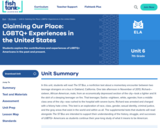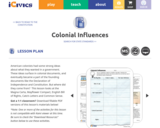
Students explore the contributions and experiences of LGBTQ+ Americans in the past and present.
- Subject:
- English Language Arts
- Material Type:
- Unit of Study
- Provider:
- Fishtank Learning
- Provider Set:
- ELA
- Date Added:
- 11/19/2021

These materials have been vetted by educators and show alignment to standards and use of research-based strategies.
The Accelerating Learning endorsement is earned when an instructional material "Meets Expectations" or "Exceeds Expectations" in the Standards Alignment and Research-Based Strategies categories of the Instructional Materials Rubric.

Students explore the contributions and experiences of LGBTQ+ Americans in the past and present.

How does internet advertising contribute to the spread of disinformation? Well-crafted headlines benefit everyone. They help readers digest information and publishers sell news stories. But what if the headline is misleading? What if it's crafted just to get clicks or even to spread disinformation? "Clickbait" headlines may benefit advertisers and publishers, but they don't benefit readers. Help students recognize and analyze clickbait when they see it. Approximately 45 mins.
LESSON OBJECTIVES: Describe how advertisers and publishers make money through online advertising. Describe how clickbait can contribute to the spread of fake news and disinformation. Use the Take a Stand thinking routine to consider different perspectives about whose responsibility it is to fight fake news and disinformation.

Students calculate elapsed time using analog clocks. Included in this lesson are a detailed plan, clock template, and video of students making their clocks.

This tutorial explains exponential functions and provides links pertaining to topics on them. You will learn to use the exponent keys on your calculator, to graph exponential functions, and to solve compound interest problems.

American colonists had some strong ideas about what they wanted in a government. These ideas surface in colonial documents, and eventually became a part of the founding documents like the Declaration of Independence and Constitution. But where did they come from? This lesson looks at the Magna Carta, Mayflower Compact, English Bill of Rights, Cato's Letters and Common Sense. LESSON OBJECTIVES: Magna Carta *English Bill of Rights *Mayflower Compact *Cato's Letters *Thomas Paine's Common Sense

From the time Columbus first set foot in the New World, Europeans were fascinated with this new land. In this American colonization lesson, students learn about the "Three Gs" that drove them here-gold, God, and glory-and find out how these settlers gave America its start, developed the land economically, and impacted Native Americans and Africans.
LESSON OBJECTIVES: Explain the three main reasons behind European exploration/colonization in North America: economics, religion, and glory. *Explain the impact of European colonization on Native Americans. *Describe the source of labor for the development of the colonial settlements. *Analyze a map of the triangle trade route.

Students learn that what you read in books can really add up when they analyze literary texts for economic concepts.

Students examine what it means to come of age and be disenfranchised as a female undocumented immigrant in a community plagued by machismo culture. While reading Angie Cruz’s Dominicana, students will track pivotal moments in the psychological or moral development of the protagonist, Ana from youth to maturity, specifically noting when she recognizes her place in the world.

The goal of the Listening and Learning Strand is for students to acquire language competence through listening, specifically building a rich vocabulary, and broad knowledge in history and science by being exposed to carefully selected, sequenced, and coherent read-alouds. The 9 units (or domains) provide lessons (including images and texts), as well as instructional objectives, core vocabulary, and assessment materials. The domain topics include: Different Lands, Similar Stories; Fables and Stories; The Human Body; Early World Civilizations; Early American Civilizations; Astronomy; Animals & Habitats; Fairy Tales; and History of the Earth.
Find the rest of the EngageNY ELA resources at https://archive.org/details/engageny-ela-archive .

The goal of the Listening and Learning Strand is for students to acquire language competence through listening, specifically building a rich vocabulary, and broad knowledge in history and science by being exposed to carefully selected, sequenced, and coherent read_alouds. The 9 units (or domains) provide lessons (including images and texts), as well as instructional objectives, core vocabulary, and assessment materials. The domain topics include: Nursery Rhymes and Fables; Five Senses; Stories; Plants; Farms; Kings and Queens; Seasons and Weather; Colonial Towns; and Taking Care of the Earth.
Find the rest of the EngageNY ELA resources at https://archive.org/details/engageny-ela-archive .

This textbook follows California Language Arts Standards for grades 9-12 to provide a generalized understanding of composition and to serve as a supplementary aid to high school English teachers.

This task develops reasoning behind the general formula for balances under continuously compounded interest. While this task itself specifically addresses the standard (F-BF), building functions from a context, a auxiliary purpose is to introduce and motivate the number e, which plays a significant role in the (F-LE) domain of tasks.

Countries often work together to solve problems and fall into conflict when problems cannot be resolved. After learning about motivations and conditions that lead to action (or inaction), students analyze examples of international conflict and cooperation. LESSON OBJECTIVES: Describe conflict and cooperation using past and current events, including the Vietnam War, the War in Afghanistan, the Kyoto Protocol, and the tsunami in Japan. *Analyze the conditions, actions, and motivations of past and current international events.

Need to teach the legislative branch in a hurry? This lesson is designed to cover the basics in a single class period. Students learn what Congress is, what the Constitution says about the legislative branch, and how a bill becomes law. They analyze some actual language from the Constitution, compare the House and the Senate, and simulate the lawmaking process by reconciling two versions of the same fictional bill.
LESSON OBJECTIVES: Explain the structure and powers of the legislative branch of the U.S. federal government. *Describe the legislative process in the U.S. Congress. *Identify the legislative branch's role in the system of checks and balances/separation of powers. *Analyze a primary source (excerpts of Article I).

How can we use code-switching to enhance our communication with online audiences? What you say, and how you say it, often depends on whom you're talking to, both in person and online. The person or people you're chatting with -- and the apps or websites you're using -- affect how we communicate. Remind your students to consider their audience before they post or comment online, and help them build community and communicate effectively in the digital world. Approximately 50 mins.
LESSON OBJECTIVES: Apply the idea of code-switching to how they use phones and other devices in and outside of school. Consider different ways that code-switching online can make communication more meaningful and effective. Write an example post or message that uses code-switching to communicate with an online audience.

What should the consequences for online hate speech be? While some governments can't regulate hate speech, laws allow private organizations like social media apps and private universities to decide how to deal with hate speech within their spheres. How should these organizations respond to hate speech? What is an appropriate consequence? Pose these questions for students, and help them think through the importance of both respect for others and free speech. Approximately 50 mins.
LESSON OBJECTIVES: Reflect on whether hate speech is considered free speech. Identify the reasons for and against regulating online hate speech. Use the Take a Stand thinking routine to consider the potential consequences of online hate speech.

After ten years under the Articles of Confederation, Americans realized they needed something different. This mini-lesson shows students the major debates that occurred at the convention, as well as the outcomes that created our system of government. LESSON OBJECTIVES: Recognize how various individuals and groups contributed to the development of the U.S. government. *Trace the impact of significant events that surrounded the founding of the United States. *Big Ideas: Articles of Confederation, alliance, federalist, three branches, checks and balances, bicameral representation, delegation of powers, U.S. Constitution

When the Founders wrote the Constitution, they didn't pull their ideas out of thin air. They created a government based on a set of fundamental principles carefully designed to guarantee liberty. This lesson lets students look at the Constitution from the perspective of its foundational principles. Students make direct connections between these principles, the Founders' intentions, and the Constitution itself, and they learn why the constitutional principles are critical to a free society.
LESSON OBJECTIVES: Analyze the basic principles of the U.S. Constitution *Identify relationships among popular sovereignty, consent of the governed, limited government, rule of law, federalism, separation of powers, and checks and balances *Describe how these principles are incorporated into the Constitution *Explain the concerns that led the Founders to value these principles

Contemporary Literature Contemporary Literature Survival. Survival. Survival Night Vocabulary The Holocaust I Never Saw Another Butterfly Elie Weisel Night Chapters 1 4 Chapters 58 Module Wrap Up Review

This short video and interactive assessment activity is designed to teach second graders about converting coins - two units.